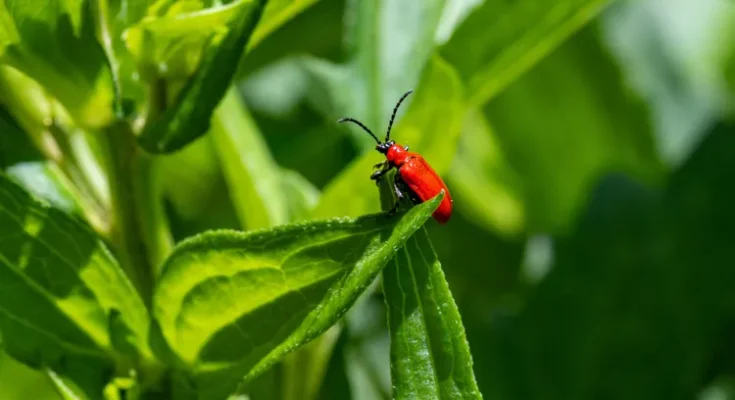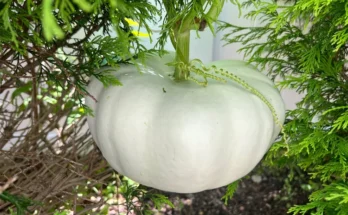Protect your lilies from destructive scarlet lily beetles with these simple and effective methods.
A major pest of true lilies and fritillarias, scarlet lily beetles—also known as lily leaf beetles—can do a lot of damage in a season. They are known to defoliate entire plants and ruin lily buds before they bloom. However, with time, consistency, and these pest control tips, you can get rid of scarlet lily beetles for good without having to break out any harsh chemicals.
What Are Scarlet Lily Beetles?
Scarlet lily beetles (Lilioceris lilii) are invasive Eurasian pests that first arrived in North America in the 1940s, likely hitching a ride on a shipment of lily bulbs or other plant matter. For years, these pests were mostly limited to areas of Canada, but they made their way to New England in the 1990s and have been spreading ever since. Experts say the pest has the potential to invade most of North America, given its native range.
Identifying Scarlet Lily Leaf Beetles
Unlike many garden pests, scarlet lily beetle adults stand out with their cherry-red bodies, black heads, and black legs. These pests measure about ¼ to ½ inch long and are strong fliers, although they tumble off plant leaves when they’re disturbed and lay motionless on the ground with their black bellies facing up. This behavior makes lily leaf beetles hard to catch and even harder to see against dark ground.
After overwintering in soil or leaf litter, adult lily beetles emerge in spring, mate, and lay eggs. Small, oblong, reddish eggs are typically on the underside of plant leaves, and they hatch into yellowish-orange, slug-like larvae in about four to eight days. These squishy larvae camouflage themselves with their own dark droppings and spend the first two to three weeks of their lives feeding on lily plants before they fall to the soil, pupate, emerge as adult beetles, and the life cycle repeats.
Signs of Scarlet Lily Beetles
Scarlet lily beetles primarily target true lilies and fritillaries and are only known to lay eggs on these specific plants. However, scarlet lily beetles sometimes also feed on other ornamentals, including hostas, lily of the valley, hollyhock, flowering tobacco, potatoes, bittersweet, and Solomon’s seal. However, daylilies, canna lilies, and calla lilies are usually safe from scarlet lily beetles, as these plants don’t belong to the “true lily” family.
If you have an active infestation of scarlet lily beetles, you may spot the beetles and their larvae feeding in groups on your lily plants. Even if you don’t see the beetles at work, these signs let you know they’re around:
- Ragged holes on lily leaves, stems, and flower buds.
- Skeletonized lily leaves and ruined flowers.
- Completely defoliated plants that have been reduced to stems.
How to Prevent and Control Scarlet Lily Leaf Beetles
Scarlet lily beetles are impressively strong fliers that can easily fly into your garden from your neighbor’s property or beyond. However, scarlet lily beetles and their eggs can also be transported into gardens on infested plants and soil amendments, so it’s important to inspect new plants carefully and purchase garden supplies from reliable sources.
Preventing pests is always best, but these tips help control existing infestations.
1. Prune infested leaves.
Adult scarlet lily beetles will likely fall off infested plants as soon as they’re disturbed, but their eggs and larvae can’t dash away so quickly. If you spot leaves that are badly infested with scarlet lily beetle larvae or eggs, cut them away and drop them into a bucket of soapy water or burn them in a fire pit. Tackling eggs before they hatch is the best way to protect lily plants from damage and save yourself the headache of dealing with scarlet lily beetles later on.
2. Use handpicking.
Handpicking is an effective way to manage scarlet lily beetle adults, larvae, and eggs, but you must move quickly to keep the adults from eluding you. For best results, place a bucket of soapy water beneath infested plant leaves and knock the beetles into the bucket with your finger or allow them to drop off the plant on their own. You can also crush these pests with your fingers, but you’ll probably want to put on gloves first.
To manage the problem, check your plants at least twice a week from April to October. Consider investing in an insect vacuum to capture the adults before they fly away. If you see adult beetles on your plants, always inspect the underside of nearby leaves for hidden eggs.
3. Apply organic controls.
Organic insecticidal soap spray, organic horticultural oil, and neem oil can all be effective against scarlet lily beetle larvae, although these products don’t work as well for adults. To be effective, oils and sprays must be reapplied at five- to seven-day intervals until the beetles are gone, and these products should only be used in the evening to avoid issues with sunscald. Diatomaceous earth can also be useful against scarlet lily beetles; however, this product can harm pollinators and should never be applied to flowers.
4. Try companion planting.
Even though scarlet lily beetles are invasive, some native insects are starting to develop a taste for these pests. Growing companion plants that attract predatory wasps near your lilies can encourage these “good guy” insects to stick around your garden and control beetle grubs for you. Some of the best companion plants for the job include yarrow, sweet alyssum, Queen Anne’s lace, and plants in the carrot family.
5. Invite predators.
While companion planting can naturally attract predatory insects to your garden, some growers may want to release parasitic wasps directly onto their lily plants for beetle control. Studies have found that certain species of predatory wasps are especially helpful for managing invasive scarlet lily beetles,1 but other predators are also interested in the beetles. Installing birdhouses near your lilies and keeping the garden as organic as possible can invite beetle predators, such as birds, toads, wasps, and ground beetles.
6. Grow resistant plants.
Scarlet lily beetles are particularly attracted to Asiatic hybrid lilies, but they also feed heavily on tiger lilies, Turk’s cap lilies, and several other common lily varieties. If you have an ongoing problem with these pests, you may want to replace some of your plants with lilies that are less appealing to pest beetles, like ‘Madame Butterfly’ (Lilium henryi) and ‘Black Beauty’ (Lilium speciosum rubrum x Lilium henryi).



